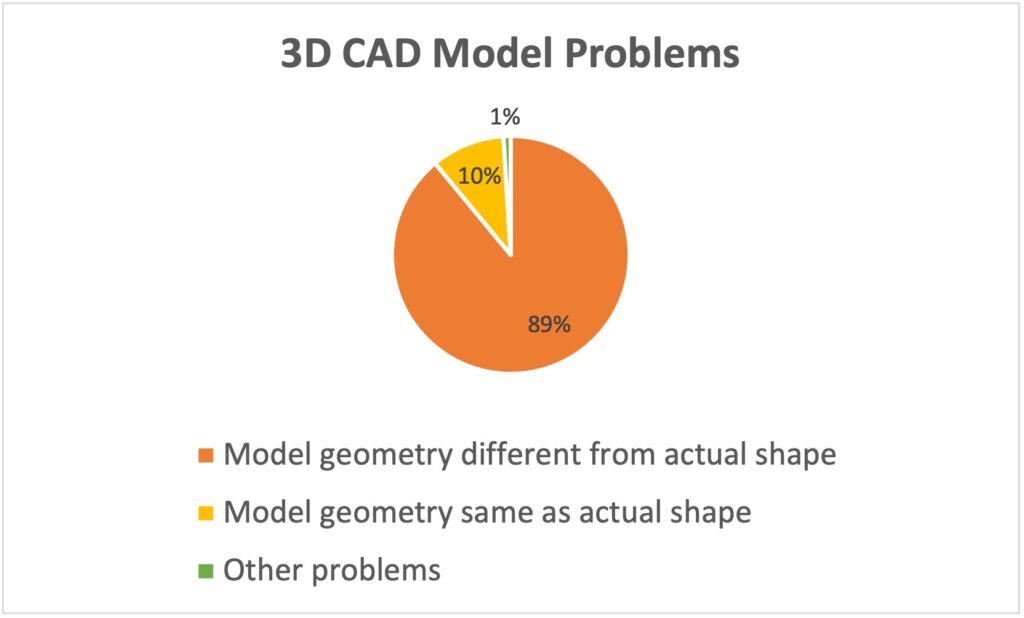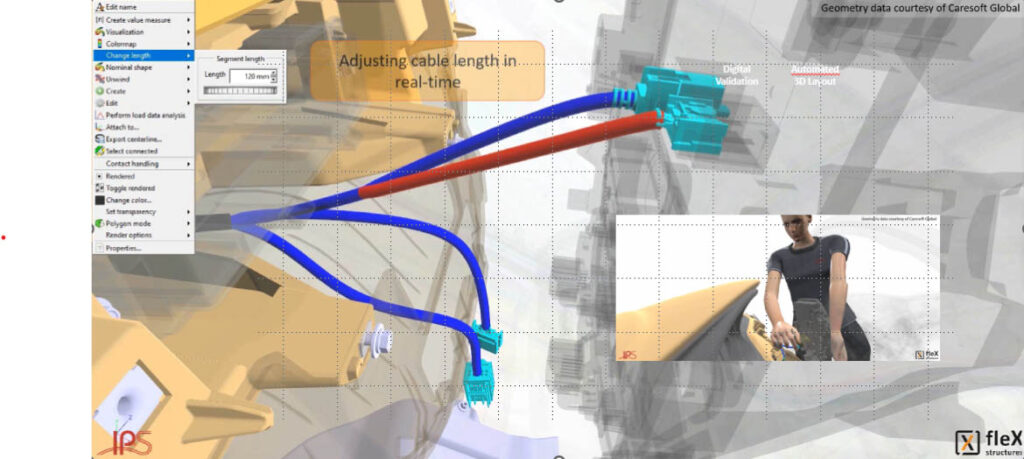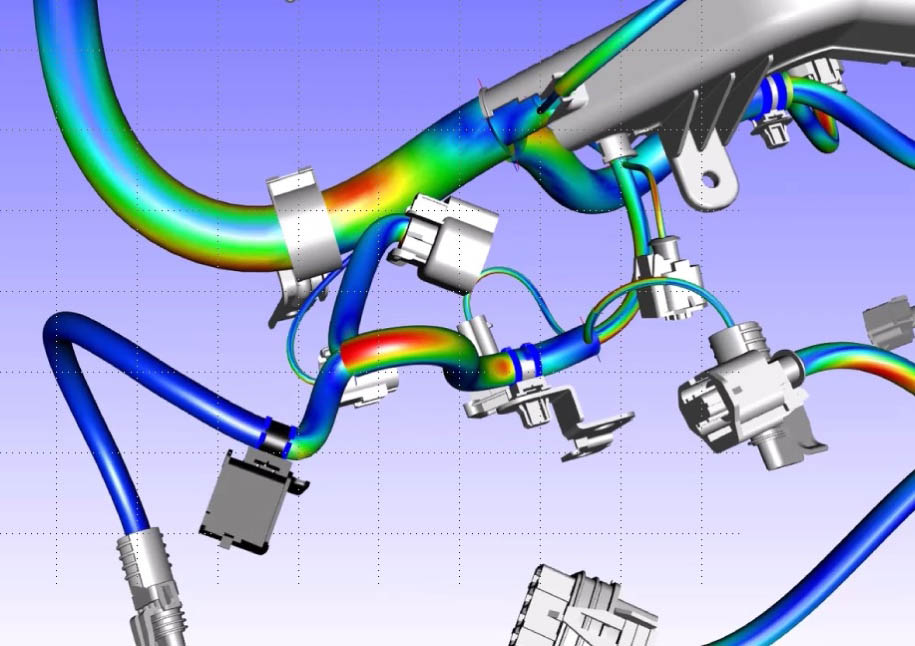Flexible cables are used in many industries allowing movement in systems for power, signal and data, either during system assembly or as a practical nature of the components eventual use. Whatever the application, the pressure is on to produce accurate flexible harness designs in the virtual world that will ensure long life and durability.
One of the drawbacks of designing in the digital realm is that traditional 3D CAD tools do not accurately depict the complex mechanical behaviors of flexible components. Just because a bundle of wires bends at a certain angle in two dimensions doesn’t mean it actually will in reality. This article deals with some of the unexpected consequences of designing components in 3D CAD. We will then look at some of the advances in model-based design to predict the behavior as cables are flexed and bended, specifically fleXstructures IPS Cable simulation software. We will then speak with some representatives of fleXstructures and their US partner Sandalwood for a deeper insight on CAD issues and cutting-edge modeling solutions.
As previously stated, there are gaps between CAD systems and reality when it comes to flexible systems like cables and harnesses. Following are some areas where they fall short:
- Unpredictable stresses on cables and hoses (such as movements, vibrations, abrasion).
- Rigid geometries and assumed spatial shapes that often do not correspond to the real-world shape of elastically deformable components.
- Different tolerances due to manufacturing and temperatures of cables and hoses.
- The service life of complex cable and hose combinations.
- The classification of geometric and functional properties—for example, according to shape and length or according to stiffness and longitudinal density.
- The assembly of the flexible components within specified parameters to prevent damage.
These problems manifest themselves in significant ways. Figure 1 depicts just how often CAD harness models depart from reality. Regardless of the reason, these gaps cost time and money, not only in the prototype stage of a harness design, but also in assembly and long-term consumer.

Figure 1. Reality gaps when designing flexible circuits in CAD.
Model-based Design
Model-based cable designs employ computer models to simulate their behavior under different loads, incorporating factors like material properties, geometry, and boundary conditions. These models enable analysis and enhancement of product performance based on specified loading conditions in the real world.
This simulation considers physical aspects of cable material, system geometry (including cross-section, length, and material thickness) and subsequently applies loads to the system. The outcomes provide insights into the load capacity and flexible characteristics of the cable or harness, allowing adjustments to the system design to meet functional requirements and to withstand various loads and geometries in the real world.
IPS Cable Simulation
On hand to discuss this important aspect of cable and harness design were Karl Bangert, General Manager of fleXstructures North America along with John Lewkowicz, Technical Lead, Digital Engineering, and Mike Vitek, Director, Systems Engineering, of Sandalwood Engineering & Ergonomics, fleXstructure’s US sales and consulting partner. Karl began with the company’s mission, saying “IPS Cable Simulation is used to virtually validate the designs of hoses, cables and wire harnesses to help our customers save time and money in the development, assembly and servicing of the components.”
The development of their cable simulation model goes back to the mid 00’s through the work of a German research organization called The Fraunhofer Institute for Industrial Mathematics (Fraunhofer ITWM), which dealt with mathematics focused on helping solve production challenges with automobiles and transportation. This was deemed to be a particular importance as they saw transportation becoming more electrified. “So, the idea was to come up with a solution where you could do simulation in real time that would lead to fast results with the ability to move things around in virtual reality,” Karl informed. That research led to a couple high-tech spinoff companies, one of which was fleXstructures Germany founded in 2012.
Three years ago, the company opened fleXstructures in North America and brought in Karl. “Very early, we recognized that in order to scale quickly, we needed to look to partner with folks who are tactical experts in the area of digital human modeling as well as VR components.” Sandalwood had been working in that space for 32 years and checked all the boxes.
Karl spoke about IPS’s high degree of interoperability. “It works in conjunction with CAD, so we’re not reinventing the w heel from that standpoint. We support a number of geometry formats so we can be part of a design process chain. Whether you’re using Catia, 3DEXPERIENCE, the Siemens NX products, PTC Creo, Zuken E3—you can take the data and read it into IPS, make improvements, then bring the information back to your CAD system to make sure the design meets the original guidelines.” These improvements, he elaborated, can be revised centerlines, a tolerance study for space claims, the creation of motion envelopes (when something is moving in a defined space) or to check for potential collisions, just to name a few.

Mike mentioned a major benefit is that you don’t need a supercomputer to run IPS. “We are able to run a number of simulations on a pretty lightweight platform like fairly standard laptop or desktop systems. We don’t need three power supplies and a gigantic heat source to run overnight simulations, and you can see the results right away.”
There are a number of ways IPS deals with material properties to predict the behavior of wire bundles or individual circuits. “It comes with a database of standard material properties for various cables and bundles. We also have some powerful estimation tools where you can tell the software the individual wires that make up a particular bundle, or some portion of a harness. It then estimates the material properties,” John explained. They also work with well-known global harness suppliers to develop a library of individual conductor types to aid in validating bundle characteristics.
John spoke more on the importance of design validations that take into account things like flexibility and bend radius. “We see a lot of harness designs in CAD and it’s really a spaghetti noodle. It will do whatever you want but it doesn’t understand how it’s supposed to move, the effects of gravity, fixation points or motion properties. So, when we put them in IPS and make them physically correct in the presence of gravity to see how they contact, it can quickly optimize the design.”
Queried about the cost of the tool, Karl maintained the tool is not cost prohibitive, especially when compared to the time and money savings in prototyping and downstream design changes. “The OEMs will be the ones with 10-20 licenses for 50 trained users, but what we are seeing in the supplier space, is that they can make a business case for it. [Harness manufacturers] can say, ‘hey we’re not just going to provide you with the item as specified, but we can make sure the application fits your needs and you’re not going to have any surprises during manufacturing or in the field.” This, he maintained, makes them an invaluable resource to their customers.
Mike dovetailed to this point discussing some of the challenges in working with engineers at the OEM level. He agreed with the assertion that many new engineers lack the benefit of having worked under the tutelage of veteran harness designers, but he makes an even more compelling point. “In the past, you had a dedicated person for things like wire harnesses, clips, and connectors. Now they’re making that part of an entire motor assembly for a battery buildup. So, the emphasis to specialize in the area of harnesses doesn’t really happen anymore. They’re concentrating more on a systems level with other things like modules, cooling, thermodynamic properties, and all the other things; then there’s a harness that attaches to it.” The implication is that it’s up to suppliers to fill the knowledge gap.
For this reason, and with the intent on reaching a broader audience, fleXstructures and Sandalwood offer different levels of service to be able to support smaller OEMs and harness suppliers. “We have a lot of clients who engage us from a very short-term consulting standpoint. They may have a particular problem with a high warranty or other high-hurt item and will ask us for help using the software. With a lot of software vendors, its either buy the software or not. But people can engage with IPS Cable Simulation from a lightweight cost standpoint.”
The company also offers physical testing services using a special machine they designed called MeSOMICS. The testing service they provide reveals things like effective bending and torsional stiffness of a cable. “We can actually take a single cable, bundle, or whatever kind of flexible assembly it may be, and actually do testing to determine the exact and precise material properties,” John revealed.
As the team touted the benefits of IPS Simulation tool, they revealed three ways they validate human factors to benefit their customers. “We’ve done a lot of projects looking at things like design for serviceability. Will the service technician have access to this point,” Mike detailed. “The other piece we focus on is the virtual assembly cycle. We do an assembly break out prior to any metal being cut or line being installed. It’s not just line of sight, but we put a digital human model together to determine if we can actually get this work done.” Finally, this software can do things like put a human model in the seat of a vehicle to see what type of controls they’re able to reach comfortably, what the range of motion needs to be, where they should be located and how the user actually interacts with them.
In conclusion, the simulation tool from fleXstructures is tailored for studying flexible components. IPS Cable Simulation provides users with diverse options for targeted design optimization in the early stages of development.
The tool ensures accurate representation of the movement and deformation of cables, cable harnesses, and hoses. It considers geometric safeguarding, assembly and production safety, and functional properties. With a user-friendly interface, IPS Cable Simulation can calculate and visually display the realistic behavior of complex cable runs in real time. With their US partner, Sandalwood they can test prototypes or problem assemblies to provide precise validation to save costs and development time.
For more information on IPS Cable Simulation go to www.flexstructures.com, or reach out directly to Karl Bangert at [email protected]
































































